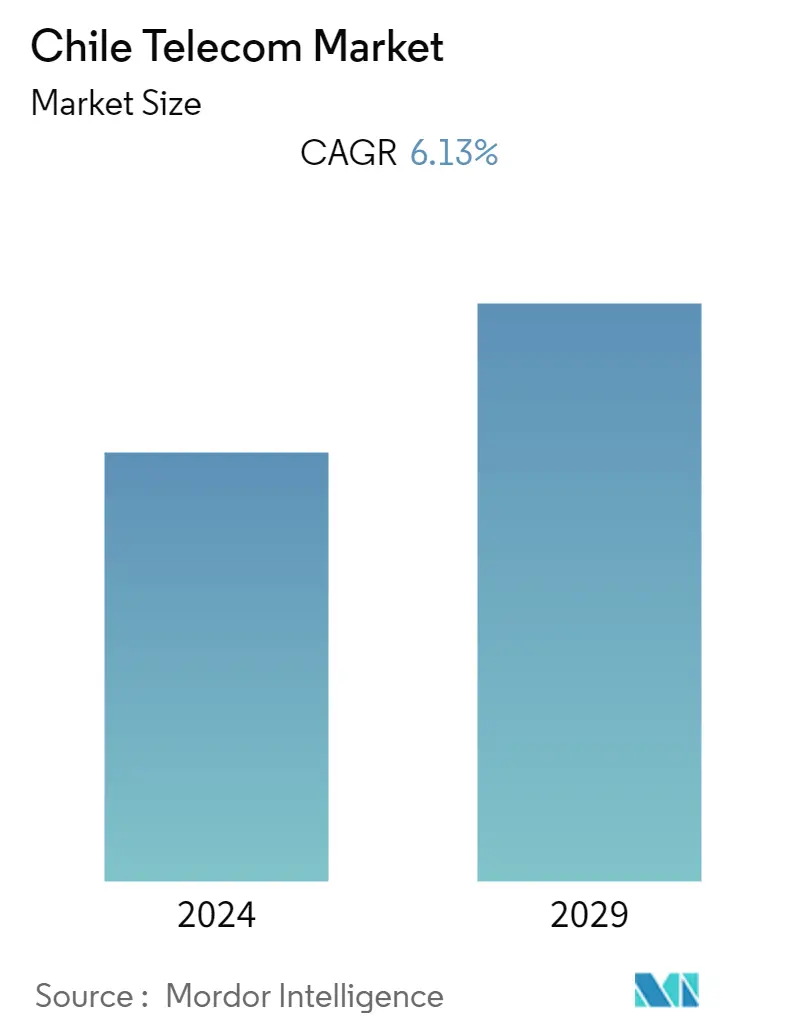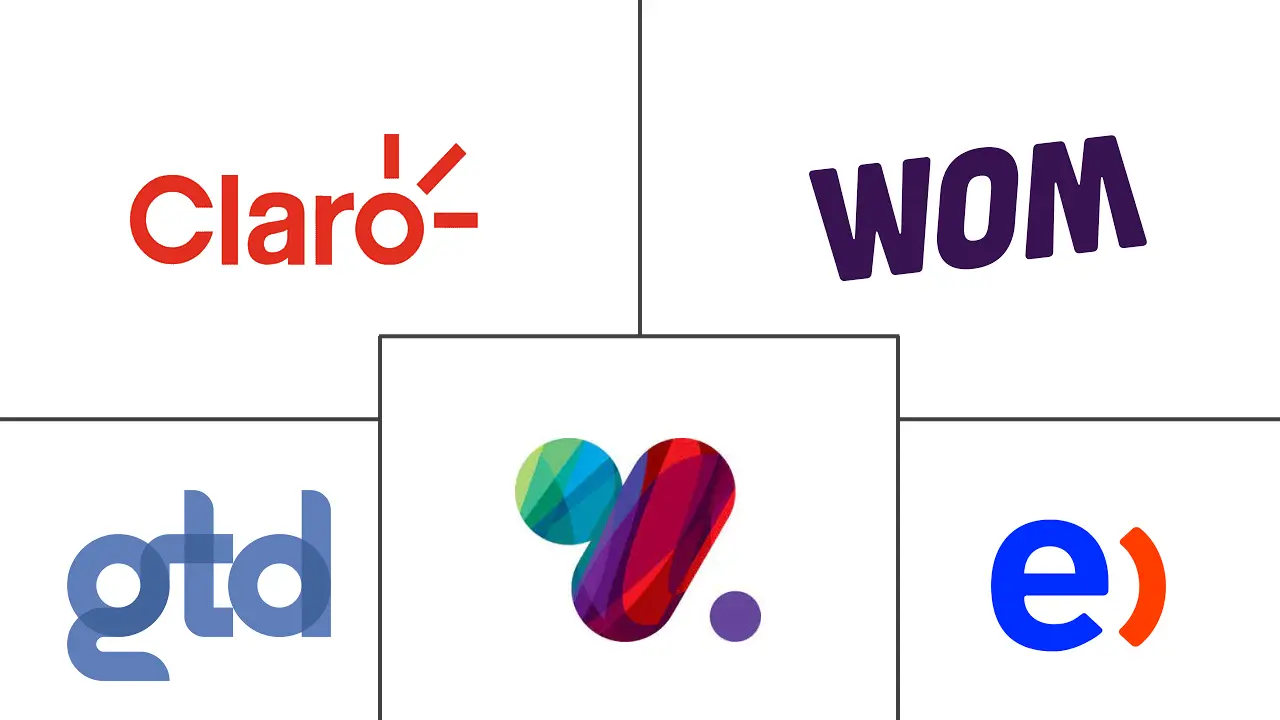Market Size of Chile Telecom Industry

| Study Period | 2019 - 2029 |
| Base Year For Estimation | 2023 |
| Forecast Data Period | 2024 - 2029 |
| Historical Data Period | 2019 - 2022 |
| CAGR | 6.13 % |
| Market Concentration | Medium |
Major Players
*Disclaimer: Major Players sorted in no particular order |
Chile Telecom Market Analysis
The Chile telecom market was valued at USD 7.22 billion in the previous year, and it is expected to reach USD 10.14 billion during the forecast period registering a CAGR of 6.13%. With several significant companies providing a variety of services, including mobile, fixed-line, and broadband internet, Chile has a well-established telecom sector. To enhance fair competition and consumer protection, the market is governed by the Telecommunications Sub-Secretariat (SUBTEL) and the Free Competition Defense Court (TDLC).
- The Chile telecom industry is growing as a result of the rise of end-user industrial sectors and applications like IoT, cloud, data centers, and 5G. The country is also seeing a rise in internet usage as a result of industrial advancements like video on demand. To fulfill the rising demand for internet services and grab a sizable share of the market, businesses are introducing an array of internet plans.
- The Mobile network is growing substantially with time due to the introduction of 5G and the increase in mobile internet speed. The usage of several devices per user, high replacement rates, and individuals switching from traditional phones to smartphones as prices dropped are all major drivers in the growth of the mobile network in the market. This is anticipated to assist the Chile telecom sector.
- Furthermore, the telecom industry is rapidly changing regarding technological developments, service delivery, competitive landscape, and telecommunication services expansion in the non-traditional telecom services section. These include managed infrastructure, data center/co-location, and cloud services.
- The country's telecom industry is also facing several challenges, including rising financial risk and rising customer sophistication. By promoting competition between a few significant players like Telefonica, VTR Chile, WOM SA, and others, service price reductions have benefited customers and emphasized the need for innovation.
- The COVID-19 shutdown increased network transport capacity, making mobile broadband more popular because most people were forced to stay at home. Many telecoms need to accelerate their 3G/4G/5G networks to allow users to connect to the Internet and stay connected with customers, as well as conduct business meetings with coworkers, clients, and other company stakeholders while working remotely.
- Post-pandemic, customers' preference for digital services like purchasing things online, mobile payments, robust collaboration tools, and many more will become the new norm for telecom service providers. Telcos should keep making investments in their network infrastructure to satisfy these demands in the future.
Chile Telecom Industry Segmentation
Telecom or Telecommunication is the long-range transmission of information by electromagnetic means. The Chile Telecom market is defined based on the revenues generated from the services used in various end-user applications across Chile. The analysis is based on the market insights captured through secondary research and the primaries. The market also covers the major factors impacting the growth of the market in terms of drivers and restraints.
The Chile Telecom Market is segmented by Services (Voice Services (Wired, Wireless), Data and Messaging Services (Coverage to Include Internet and Handset Data Packages and Package Discounts), and OTT and PayTV Services). The market sizes and forecasts are provided in terms of value (USD) for all the above segments.
| By Services | ||||
| ||||
| Data and Messaging Services (Coverage to include Internet & Handset Data packages, and Package Discounts) | ||||
| OTT and PayTV Services |
Chile Telecom Market Size Summary
The telecom market in Chile is characterized by a robust infrastructure and a competitive landscape, driven by significant players such as Telefonica, WOM SA, and others. The sector is regulated by entities like the Telecommunications Sub-Secretariat (SUBTEL) and the Free Competition Defense Court (TDLC) to ensure fair competition and consumer protection. The market is experiencing growth due to the increasing demand for advanced services such as IoT, cloud computing, data centers, and 5G technology. The rise in internet usage, fueled by industrial advancements like video on demand, is prompting telecom companies to introduce a variety of internet plans to capture a larger market share. The mobile network segment is expanding significantly, supported by the rollout of 5G technology and the transition from traditional phones to smartphones, which is further enhancing mobile internet speeds and connectivity.
The Chilean telecom industry is also witnessing a shift towards digital services, with post-pandemic trends indicating a preference for online shopping, mobile payments, and collaboration tools. This shift is driving telecom providers to invest in network infrastructure to meet the growing demand for high-speed data and messaging services. The deployment of 5G networks is particularly noteworthy, as it offers faster data speeds and lower latency, catering to the increasing consumption of data-intensive applications like video streaming and online gaming. Government initiatives, such as the Chile Digital 2035 strategy and support from the Inter-American Development Bank, are fostering digital transformation and encouraging investment in 5G infrastructure. These developments are expected to enhance the country's economic growth and competitiveness, making the telecom market in Chile a dynamic and evolving sector with significant growth potential.
Chile Telecom Market Size - Table of Contents
-
1. MARKET INSIGHTS
-
1.1 Market Overview
-
1.2 Industry Ecosystem Analysis
-
1.3 Industry Attractiveness - Porter's Five Forces Analysis
-
1.3.1 Bargaining Power of Suppliers
-
1.3.2 Bargaining Power of Consumers
-
1.3.3 Threat of New Entrants
-
1.3.4 Threat of Substitutes
-
1.3.5 Intensity of Competitive Rivalry
-
-
1.4 Assessment of the Impact of COVID-19 on the Industry Ecosystem
-
1.5 Regulatory Landscape in Chile
-
-
2. MARKET SEGMENTATION
-
2.1 By Services
-
2.1.1 Voice Services
-
2.1.1.1 Wired
-
2.1.1.2 Wireless
-
-
2.1.2 Data and Messaging Services (Coverage to include Internet & Handset Data packages, and Package Discounts)
-
2.1.3 OTT and PayTV Services
-
-
Chile Telecom Market Size FAQs
What is the current Chile Telecom Market size?
The Chile Telecom Market is projected to register a CAGR of 6.13% during the forecast period (2024-2029)
Who are the key players in Chile Telecom Market?
GTD Grupo Teleductos SA, Empresa Nacional de Telecomunicaciones SA, VTR FINANCE NV, Claro Chile (AMÉRICA MÓVIL SAB DE CV) and WOM SA are the major companies operating in the Chile Telecom Market.

